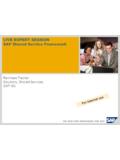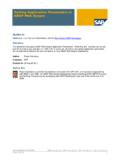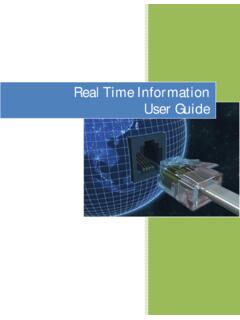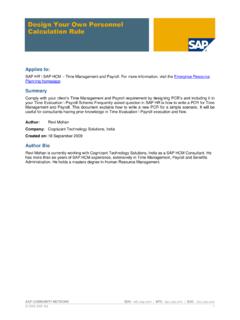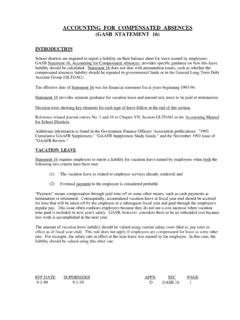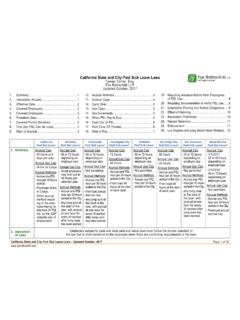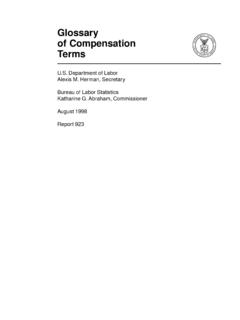Transcription of Understanding Absence Quotas - Nicx
1 Understanding Absence Quotas Applies to: c and later versions. For more information, visit the Business Process Modeling homepage. Summary Absence Quotas are used to manage an employee s time off. Various quota types (such as vacation or sick time) are set up to allow the employee a particular number of hours or days off. Absence quota information is stored in Infotype 2006 Absence Quotas , and can be paid out using Infotype 0416 Time Quota Compensation. These Infotypes have been available since release and replace leave functionality in Infotypes 0005 Leave Entitlement and 0083 Leave Compensation. Although, the leave functionality (0005/0083) can still be used, it is recommended to use the new, more robust quota functionality. Author: Pulla Rao Company: Sparta Consulting Inc Created on: 13 August 2009 Author Bio Pulla Rao Sparta is a Sr.
2 HCM functional Consultant at Sparta Consulting Inc SAP COMMUNITY NETWORK SDN - | BPX - | BOC - 2009 SAP AG 1 Understanding Absence Quotas Table of Contents Introduction to Absence Quotas .. 3 Quota Terminology Explained .. 3 Quota Groupings and How They Interact .. 4 Employee Subgroup Grouping (ESG) for Time Quotas .. 4 Personnel Subarea Groupings (PSG) for Time Quotas .. 4 Personnel Subarea Grouping (PSG) for Time Recording .. 5 Specify Rule Groups for Quota Type Selection .. 6 Creating an Absence Quota Type .. 8 Setting the Accrual Method for Quota Types .. 9 Counting Rules .. 9 Deduction Rules .. 12 Define the Deduction Rule .. 12 Link Deduction Rule to Counting Rule .. 13 Rules for Generating Absence Quotas .. 14 Step 1: Specify Rule Groups for Quota Types .. 14 Step 2: Set Base Entitlements.
3 15 Step 3: Determine Validity and Deduction Periods .. 16 Step 4: Define Generation Rules for Quota Selection .. 17 Time Evaluation Results .. 23 Carryover of Quotas from Year to Year .. 25 Features, Functions, and Operations Used in Quota Processing .. 25 Features .. 25 HDATE .. 25 Functions .. 26 QUOTA .. 26 CUMBT .. 28 ACTIO .. 29 Operations .. 29 UPDTQ - Update Absence Quota .. 29 VARST - Provide General Fields .. 29 OUTAQ - Retrieve Information from Absence Quotas .. 29 OUTTI - Retrieve Fields from IT0007 .. 29 HRS Change/Compare Hours Field .. 30 Front Loading vs. Accrual of Entitlements .. 30 Disclaimer and Liability Notice .. 31 SAP COMMUNITY NETWORK SDN - | BPX - | BOC - 2009 SAP AG 2 Understanding Absence Quotas Introduction to Absence Quotas Absence Quotas are used to manage an employee s time off.
4 Various quota types (such as vacation or sick time) are set up to allow the employee a particular number of hours or days off. Absence quota information is stored in Infotype 2006 Absence Quotas , and can be paid out using Infotype 0416 Time Quota Compensation. These Infotypes have been available since release and replace leave functionality in Infotypes 0005 Leave Entitlement and 0083 Leave Compensation. Although, the leave functionality (0005/0083) can still be used, it is recommended to use the new, more robust quota functionality. Quota Terminology Explained Accrual an amount of time credited to an employee s account of allowed time for a certain Absence . An accrual can be characterized by 1) how the amount to be credited is determined, and 2) the time frequency of the credit. The amount to be credited can be a constant amount or variable based on seniority, age, or other criteria in the company policy.
5 The frequency of credit may vary from annually to daily. An example of a simple accrual would be for personal holiday time where every employee receives 16 hours, credited once a year on January 1. An example of a more complex accrual would be vacation time based on seniority, calculated daily and credited at the end of each pay period. Some accruals are held in a table maintained during time evaluation. Accrued time may or may not be available for use by employees. See transfer time. Manual accrual a quota where the allotment amount and timing of creating the infotype record are done by user-initiated transaction ( PA61) rather than via a program. Very little configuration is required for manual accruals beyond creating the quota type. The manual accrual is used for accruals which can be created quickly and may not be applied to all employees all of the time.
6 An example of this would be jury duty. An employee would not be eligible to take jury duty until they have been accepted on a jury. At that time a quota could be created so they can then record jury duty Absence . This would mean that the employer would not carry a liability for accrued Absence time unless the Absence was in the near future. Automatic accrual - a quota where the allotment amount and timing of populating the infotype record are done via a program. Configuration of quota selection rules is required for automatic accruals. Automatic quota accruals are very useful for implementing Quotas that are held by many segments of the employee population and are based on tier rules such are yearly granted or seniority based accrual. Two examples of these are sick or vacation time. The automatic accrual could be created by either running RPTQTA00 without the use of time evaluation or during time evaluation (RPTIME00.)
7 The majority of this document is devoted to Quotas that are automatically accrued. Entitlement an amount of time available to an employee, to be used to limit time off for one or more specific absences. This may or may not be the same as accrued time, depending on the transfer time of the quota. Absence types tied to Quotas check the amount of remaining entitlement to determine if the Absence is allowable. Absence records or quota compensation records reduce the remaining entitlement, but not the total amount of the entitlement. The entitlement field can be changed manually, by quota selection rules, or via personnel calculation rules depending on the accrual method of the quota. Transfer time the point at which an accrual amount is used to populate the entitlement field of a quota. The transfer can increase or replace an existing entitlement.
8 For manual accruals, the transfer is immediate, taking place when the user creates or changes the infotype record. For automatic accruals, the transfer time is configured as part of the quota selection rule and occurs during program execution. SAP COMMUNITY NETWORK SDN - | BPX - | BOC - 2009 SAP AG 3 Understanding Absence Quotas Quota Groupings and How They Interact Employee Subgroup Grouping (ESG) for Time Quotas Menu Path: Personnel Time Management>Time Data Recording and Administration>Managing Time Accounts Using Attendance/ Absence Quotas >Setting Groupings for Time Quotas >Group Employee Subgroups for Time Quotas Employee subgroups for which the same attendance and Absence quota types are defined are assigned to the same grouping for time quota types. In your personnel structure, if you have employee subgroups that are entitled to use the same quota types, you can use just one grouping (such as 1) for all of the employee subgroups.
9 If, however, distinctions need to be made as far as different quota types being available for different employee subgroups, you will need to use different subgroup groupings for your employee subgroups. Personnel Subarea Groupings (PSG) for Time Quotas Menu Path: Personnel Time Management>Time Data Recording and Administration>Managing Time Accounts Using Attendance/ Absence Quotas >Setting Groupings for Time Quotas >Group Employee Subgroups for Time Quotas Personnel subareas for which the same attendance and Absence quota types are defined are assigned to the same grouping for time quota types. In your Enterprise structure, if you have personnel subareas that are entitled to use the same quota types, you can use just one grouping (such as 10) for all of the personnel subareas. If, however, distinctions need to be made as far as different quota types being available for different personnel subareas, you will need to use different subarea groupings for your personnel subareas.
10 SAP COMMUNITY NETWORK SDN - | BPX - | BOC - 2009 SAP AG 4 Understanding Absence Quotas It is important to note that each grouping within Time Management (such as PSG for work schedules, PSG for substitutions, PSG for attendance/ Absence types, etc) is independent of one another. Personnel Subarea Grouping (PSG) for Time Recording Menu Path: Personnel Time Management>Time Evaluation>Time Evaluation Settings>Set Personnel Subarea Groupings for Time Recording In most cases, using 01 for all personnel subareas is sufficient. If, however, your company wants to differentiate in terms of time transfers, access control, time types and time type determination, or error processing, you can add additional groupings. Note: The standard time types are all created under PSG 01. Therefore, if you choose to use another PSG (other than the standard-delivered 01), you must copy all the delivered time types to your grouping for time evaluation to work.
